Paul Revere's Ride Revisited
Fred Lynch's Drawings of a Changing America
Fred Lynch's Drawings of a Changing America
Drawing along the exact route of Paul Revere’s famous ride from Boston to Lexington, Massachusetts (and beyond), Fred Lynch draws landmarks of the past and present, forming a visual essay that explores, documents and reveals history, preservation and change in America.
You can follow along with Fred's project at his blog, Paul Revere's Ride Revisited.
Fred Lynch is an illustrator, artist and professor of Illustration at Rhode Island School of Design, his alma mater. He also teaches each summer in Viterbo, Italy as part of Montserrat College of Art's Study Aboad Program.
©Fred Lynch All rights reserved.
You can follow along with Fred's project at his blog, Paul Revere's Ride Revisited.
Fred Lynch is an illustrator, artist and professor of Illustration at Rhode Island School of Design, his alma mater. He also teaches each summer in Viterbo, Italy as part of Montserrat College of Art's Study Aboad Program.
©Fred Lynch All rights reserved.

The Lost Convent
Somerville, Massachusetts
This is where the convent was, but that was a long time ago. You wouldn’t know it if you didn’t read the stone marker in front of the library, around the corner. Then again, the convent wasn’t here very long. Now it’s all multi-family houses.
When Paul Revere rode by, nearby, on what’s now Broadway, this was just a big empty hill called Mt. Benedict. In the late 1820s, a convent and school was built here by the Ursuline Sisters, a Catholic order of nuns who had outgrown their space in Boston. At the time, this was part of Charlestown; now it’s what’s referred to as East Somerville.
Boston and its suburbs have a large percentage of Catholics now, but up through the Revolutionary War, Catholics were not very welcome in this Puritan-founded area. Nonetheless, the Ursuline school quickly established itself as a place for educating the daughters of wealthy families—Unitarians, mostly.
Meanwhile, tensions were growing in Boston due to the newly arriving Irish (Catholics). The working-class Protestants saw them as an economic as well as a cultural threat. Preachers and publications fanned the anti-Irish hatred. There were attacks on the streets.
Soon the Ursuline convent became a object of resentment, too. This school for the rich, run by Catholics, became the subject of rumors and suspicions. There were calls for investigations following accusations of children being forced to convert, and women being held against their will. The convent was accused of being immoral and un-American.
Things boiled over on the night of August 11,1834. A riot of locals set fire to the convent. When firemen came, they chose not to act, and joined the growing crowd. Within hours, the convent was a smoking ruin.
An investigation led to some arrests, but juries failed to find anyone guilty. No compensation for the tremendous loss was ever made. No one was punished.
In time, the entire hill was taken away along with the ruins. A highway was built. A neighborhood grew.
As I walked the streets, I noticed that the intersections were named for war veterans. Irish names. Italian names. On front doors, hung palm branches from Palm Sunday. The Catholics had returned. And on this hill of hate, a diverse neighborhood grew. I saw lots of types come and go from these houses.
After drawing, I had a burrito at the nearby Taco Loco. There, everyone spoke Spanish but me. This place attracts all the Latino immigrants. In the age of Trump, I fear that they are the new nervous.
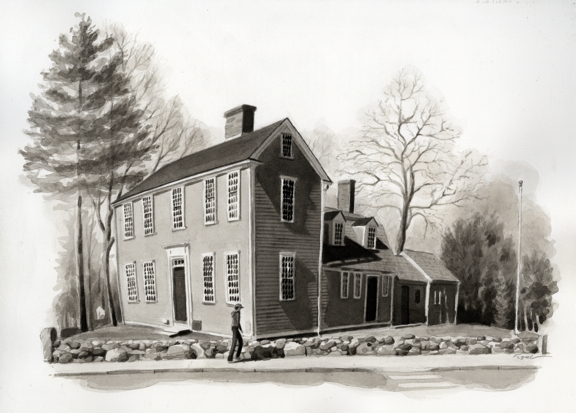
The Hancock Clark Parsonage
Lexington, Massachusetts
The It was midnight when Paul Revere arrived at his actual destination on the night of his famous ride: the home of Lexington’s clergyman Jonas Clark. In the house, a short distance from the town’s Common, Colonial rabblerousers John Hancock and Samuel Adams were hiding out, and had been for over a week. Revere (and other riders) had been sent by Colonial leader Dr. Joseph Warren to warn them of oncoming British, and the likelihood of their arrest. Revere knew exactly where to go that night as he had run the route a week earlier.
Arriving in haste from his hour-long ride, he came upon Sergeant William Munroe and about a dozen other Lexington militiamen, who were guarding the house. Munroe didn’t know Revere and when Revere called out, he was ordered to quiet down, because everyone in the house was trying to sleep!
“Noise!” Paul Revere exclaimed, “You’ll have noise enough before long. The Regulars [British] are coming out!”
Lexington, Massachusetts
The It was midnight when Paul Revere arrived at his actual destination on the night of his famous ride: the home of Lexington’s clergyman Jonas Clark. In the house, a short distance from the town’s Common, Colonial rabblerousers John Hancock and Samuel Adams were hiding out, and had been for over a week. Revere (and other riders) had been sent by Colonial leader Dr. Joseph Warren to warn them of oncoming British, and the likelihood of their arrest. Revere knew exactly where to go that night as he had run the route a week earlier.
Arriving in haste from his hour-long ride, he came upon Sergeant William Munroe and about a dozen other Lexington militiamen, who were guarding the house. Munroe didn’t know Revere and when Revere called out, he was ordered to quiet down, because everyone in the house was trying to sleep!
“Noise!” Paul Revere exclaimed, “You’ll have noise enough before long. The Regulars [British] are coming out!”
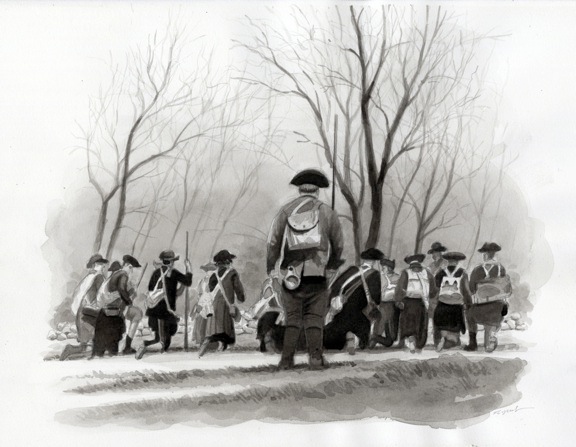
Parker's Revenge
Walking the Battle Road on the weekend of Patriots Day, I too, came across a nervous band of patriots and not far from “Parker’s Revenge.” Turns out, it was the modern version of the Lexington Minute Men. I sat on a stone wall and sketched as the leader of the group prepared his men for a reenactment of the famous skirmish scheduled in a short hour’s time.
The commander showed impatience with his rag tag group. He was concerned the coordination of musket fire was sloppy. Over and over they practiced how the two rows of men should fire and reload. He was insistent they get it right before engaging in battle. Captain Parker would be proud.
Walking the Battle Road on the weekend of Patriots Day, I too, came across a nervous band of patriots and not far from “Parker’s Revenge.” Turns out, it was the modern version of the Lexington Minute Men. I sat on a stone wall and sketched as the leader of the group prepared his men for a reenactment of the famous skirmish scheduled in a short hour’s time.
The commander showed impatience with his rag tag group. He was concerned the coordination of musket fire was sloppy. Over and over they practiced how the two rows of men should fire and reload. He was insistent they get it right before engaging in battle. Captain Parker would be proud.
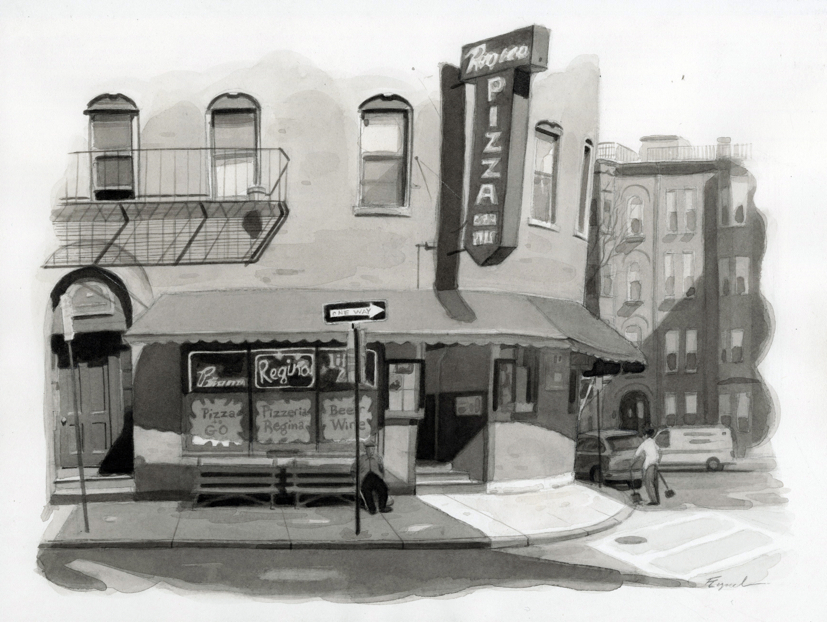
Pizzeria Regina
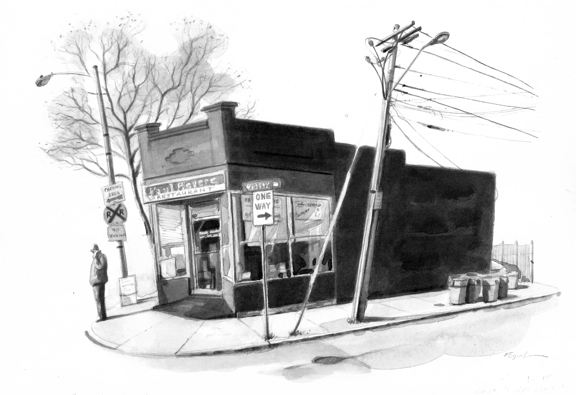
The Paul Revere Restaurant
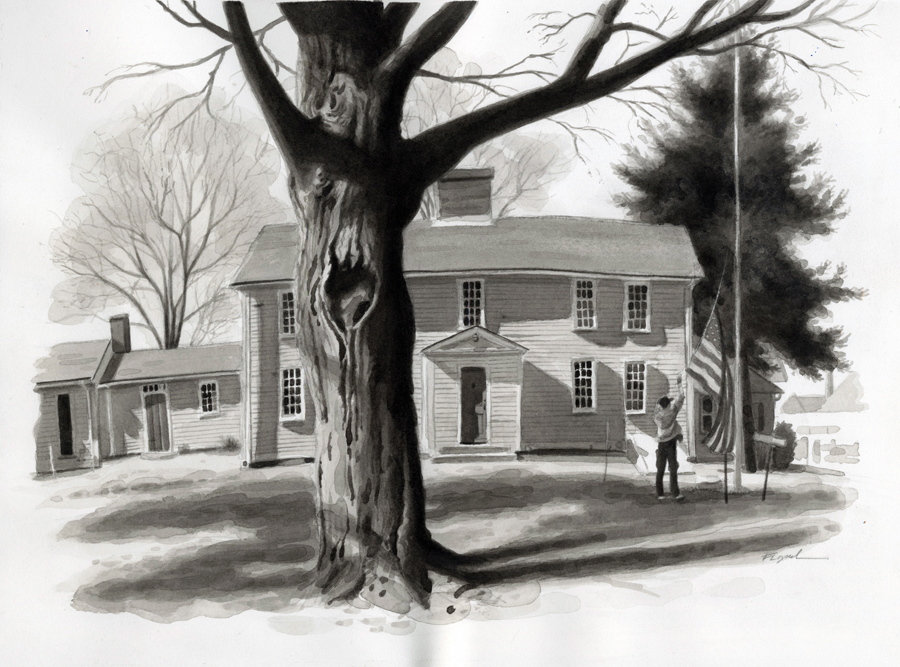
The Jason Russell House

By the Landing Marker of Paul Revere

The Stone Building

Paul Revere's Change of Direction

The Mystic River is only seven miles long and it’s not very wide. But, it played a large role in American history. The name itself may sound familiar, as it was the title of a popular movie directed by Clint Eastwood and Sean Penn. The movie was an adaptation of the novel by Dennis Lehane, the bestselling Boston author.
On his way to Lexington, Paul Revere crossed the Mystic River by way of what is now the Cradock Bridge in Medford. The first bridge built here, in 1637, was a wooden drawbridge: the first toll bridge in New England. It was rebuilt in 1880 and 1909 according to a nearby sign. Plans are currently underway for another upgrade, at an estimated cost of 8.5 million dollars.
It was along the Mystic’s banks that Massachusetts’s first ship was built in 1631. It was the first of many. Over 500 clipper ships were built here through the 1800′s, many designed for the China trade.
This area was also known for its rum. Old Medford Rum was popular and advertised as “the best rum in the states”.
This area was also known for its rum. Old Medford Rum was popular and advertised as “the best rum in the states”.
But most interesting to me, is the connection between this bridge and a song from my childhood: “Over the River and Through the Wood.” The song, which was sung in grade school, was originally written as a poem by Lydia Maria Child, the 1800′s women’s rights activist and abolitionist, who grew up in Medford. In the rolling song, Child describes her Thanksgiving trip to her grandparents house, over an earlier bridge at this same spot.
Over the river and thru the wood,
To grandfather’s house we go:
The horse knows the way,
To carry the sleigh,
Thru the white and drifted snow, oh!
The horse knows the way,
To carry the sleigh,
Thru the white and drifted snow, oh!
Over the river and thru the wood,
Oh, how the wind does blow:
It stings the toes,
And bites the nose,
As over the ground we go.
It stings the toes,
And bites the nose,
As over the ground we go.
Over the river and thru the wood, To have a first-rate play;
Oh, hear the bell ring,
”Ting-a-ling-ling!”
Hurrah for Thanksgiving Day-ay!
Oh, hear the bell ring,
”Ting-a-ling-ling!”
Hurrah for Thanksgiving Day-ay!

